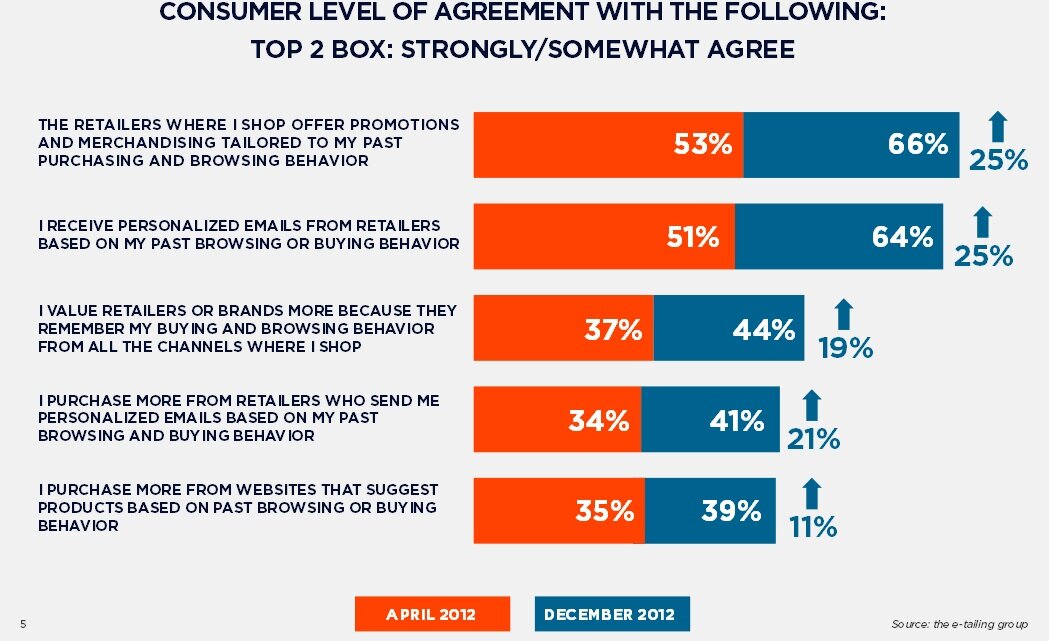5 ways to personalize beyond cross-sells
April 9, 2013 Leave a Comment
Personalization is becoming increasingly popular on shopping sites large and small, with nearly half of the Internet Retailer Top 500 merchants employing some means of matching shoppers with relevant products based on past behavior or purchases. And new research shows that investments in personalization are worthwhile: according to a recent study from the E-Tailing Group and MyBuys, both awareness and appreciation of personalized offers is on the rise among consumers. Close to half of consumers say they value brands more when tailored product recommendations are offered — an increase of nearly 20% over six months. The percentage of shoppers who say they buy more based on personalized offers via email has similarly grown, by 21%, while the percentage of those who say they buy more based on on-site recommendations has grown by 11%.

For merchants, the challenge is how to truly integrate personalization throughout the shopping experience — not just in cross-sells or emails featuring recommended products. Strategies to consider:
Let shoppers actively personalize the experience without registering. First-time site visitors are likely just as eager as frequent buyers to see relevant products — but requiring them to register for an account in order to show them tailored recommendations can be too steep of a hurdle for shoppers unfamiliar with a brand. So devise ways to let shoppers tailor site content and products to suit their needs on the fly, as Destination XL does with its Size Profile. After clicking through five sizing questions, shoppers can opt to “save for current visit” or create an account, and then proceed to browse categories with only items matching their size displayed. They can turn the profile filter on or off at any time from a link accessible in the left-hand navigation.

Use geolocation — and not just for mobile. Merchants can mine location-based data delivered by the Web browser to deliver relevant site content without asking for it. L’Oreal Paris’ home page features a callout displaying the shopper’s local weather with a beauty tip related to the climate.

Similarly, the Home Depot uses geographic data to propose which of its physical store locations is closest to the shopper and uses this information to display in-store product inventory. Even if the location isn’t always correct, highlighting the feature and inviting shoppers to engage and select a different store if necessary calls attention to the depth of in-store information available on the site.

Make past site activity accessible. Rather than simply mining past visit behaviors to inform product recommendations, merchants should share the data prominently with shoppers themselves, as a prompt to help them recollect what they’ve already considered or even added to cart. Most merchants feature a “recently viewed products” display on product pages, but home goods site Hayneedle.com anchors the tool at the bottom of the page with a floating menu, along with access to the shopping cart.

Outdoor outfitter Cabela’s features recently viewed items prominently on the home page to quickly orient returning visitors.

Inform on-site search — including “zero results”. Merchants should use shoppers’ past behavior to weight on-site search results, elevating items in the results set whose brand, size, color or price are similar to previously-viewed items. And they should use that same data to populate the “no results found” page with product recommendations, transforming a potential dead end into a display of potentially relevant items. Shoes.com offers shoppers whose search returns no results a bevy of product options, including items from categories they’ve already browsed and brands they’ve already perused.

Spotlight the ultimate personalization tool: customer service. While automated recommendations can deliver a relevant experience, there’s nothing like a real human’s discernment to match shoppers with exactly the right products — so merchants should encourage shoppers to connect in person with customer service staff with their questions. Merchants should make customer service access prominent throughout the site and emphasize staff expertise, as jewelry site Blue Nile does when inviting shoppers to connect with customer service, noting that staffers are non-commissioned so have no incentive to sell more expensive items.

Some merchants have taken this concept even further, offering personal shopping services free to site browsers or as a loyalty club perk. And a small number of online merchants are building new business models premised on the highest level of personal service, such as Trunk Club, which offers men personal shoppers who select ensembles based on style preferences set on the Web site.

How are you personalizing the shopping experience to drive engagement and sales?
Connect with us: